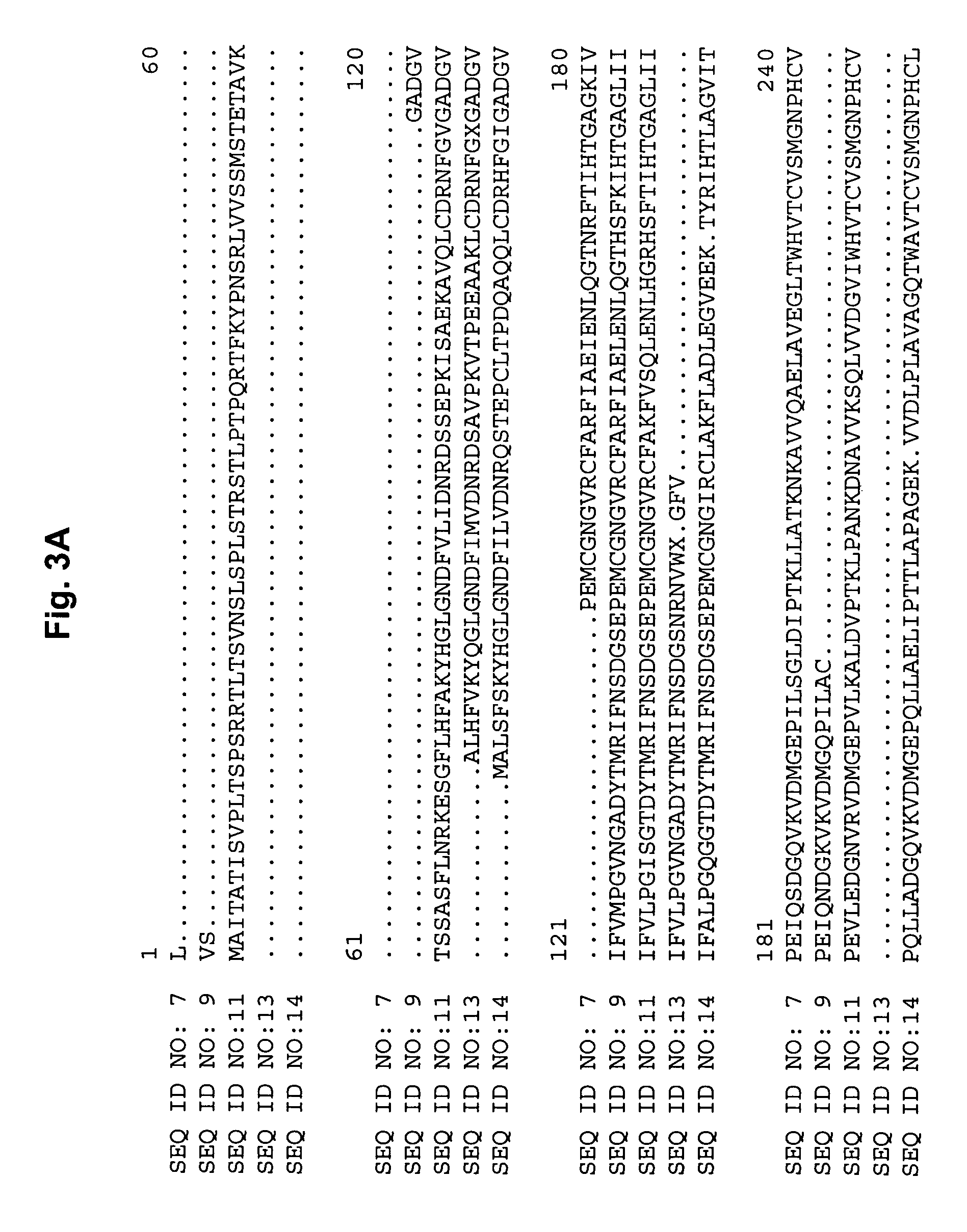Plant amino acid biosynthetic enzymes
a technology of amino acid biosynthesis and plant protein, which is applied in the field of plant molecular biology, can solve the problems of limited use of soybean meal, rich in lysine and tryptophan, and inability to manufacture a number of amino acids, and achieve the effect of inhibiting activity
- Summary
- Abstract
- Description
- Claims
- Application Information
AI Technical Summary
Benefits of technology
Problems solved by technology
Method used
Image
Examples
example 1
Composition of cDNA Libraries; Isolation and Sequencing of cDNA Clones
[0105]cDNA libraries representing mRNAs from various corn, rice, soybean and wheat tissues were prepared. The characteristics of the libraries are described below.
[0106]
TABLE 2cDNA Libraries from Corn and Soybean TissuesLibraryTissueClonecc2Corn Callus, Partially Differentiated, 2 Weeks Aftercc2.pk0031.c9Subculturecc3Corn Callus, Mature Somatic Embryocc3.mn0002.d2cen1Corn Endosperm 12 Days After Pollinationcen1.pk0064.f4chp2Corn Leaf, 11 Day Old Plantchp2.pk0008.h4cs1Corn Leaf, Sheath 5 Week Old Plantcs1.pk0058.g5csi1nCorn Silk*csi1n.pk0042.a3rls2Rice Leaf 15 Days After Germination, 2 Hours After Infectionrls2.pk0017.d3of Strain Magaporthe grisea 4360-R-67 (AVR2-YAMO);Susceptiblerls48Rice Leaf 15 Days After Germination, 48 Hours Afterrls48.pk0036.h10Infection of Strain Magaporthe grisea 4360-R-67 (AVR2-YAMO); Susceptiblerls72Rice Leaf 15 Days After Germination, 72 Hours Afterrls72.pk0018.e7Infection of Strain Maga...
example 2
Identification and Characterization of cDNA Clones
[0108]ESTs encoding plant amino acid biosynthetic enzymes were identified by conducting BLAST (Basic Local Alignment Search Tool; Altschul, S. F., et al., (1993) J. Mol. Biol. 215:403–410); searches for similarity to sequences contained in the BLAST “nr” database (comprising all non-redundant GenBank ODS translations, sequences derived from the 3-dimensional structure Brookhaven Protein Data Bank, the last major release of the SWISS-PROT protein sequence database, EMBL, and DDBJ databases). The cDNA sequences obtained in Example 1 were analyzed for similarity to all publicly available DNA sequences contained in the “nr” database using the BLASTN algorithm provided by the National Center for Biotechnology Information (NCBI). The DNA sequences were translated in all reading frames and compared for similarity to all publicly available protein sequences contained in the “nr” database using the BLASTX algorithm (Gish, W. and States, D. J....
example 3
Characterization of cDNA Clones Encoding Polypeptides Homologous to Dihydrodipicolinate Reductase
[0109]The BLASTX search using the nucleotide sequences from clones csi1n.pk0042.a3 and rls2.pk0017.d3 revealed similarity of the protein encoded by the cDNA to Synechocystis sp. dihydrodipicolinate reductase enzyme (DDBJ Accession No. D90899). BLAST pLog values were 12.60 and 11.68 for csi1n.pk0042.a3 and rls2.pk0017.d3, respectively.
[0110]The sequence of the entire cDNA insert in clone csi1n.pk0042.a3 was determined and is shown in SEQ ID NO:1; the deduced amino acid sequence of this cDNA is shown in SEQ ID NO:2. The amino acid sequence set forth in SEQ ID NO:2 was evaluated by BLASTP, yielding a pLog value of 36.72 versus the Synechocystis sp. dihydrodipicolinate reductase sequence. The sequence of a portion of the cDNA insert from clone rls2.pk0017.d3 is shown in SEQ ID NO:3; the deduced amino acid sequence of this cDNA is shown in SEQ ID NO:4. FIG. 2 presents an alignment of the amin...
PUM
| Property | Measurement | Unit |
|---|---|---|
| Volume | aaaaa | aaaaa |
| Volume | aaaaa | aaaaa |
| Time | aaaaa | aaaaa |
Abstract
Description
Claims
Application Information
 Login to View More
Login to View More - R&D
- Intellectual Property
- Life Sciences
- Materials
- Tech Scout
- Unparalleled Data Quality
- Higher Quality Content
- 60% Fewer Hallucinations
Browse by: Latest US Patents, China's latest patents, Technical Efficacy Thesaurus, Application Domain, Technology Topic, Popular Technical Reports.
© 2025 PatSnap. All rights reserved.Legal|Privacy policy|Modern Slavery Act Transparency Statement|Sitemap|About US| Contact US: help@patsnap.com



